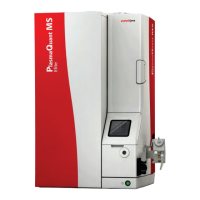Function and setup of the PlasmaQuant MS PlasmaQuant MS product family
24
Inert sample introduction system for geochemical type samples containing
hydrofluoric acid (torch with sapphire injector, PFA nebulizer, PFA spray chamber,
PFA transfer tube)
Sample introduction system for organic samples recommended for alcohols,
kerosene, etc. (torch with 1.5 mm injector, solvent-resistant pump tubing)
Sample introduction system for volatile organic samples: recommended for
gasoline, naphtha, etc. (torch with 1.5 mm injector, viton pump tubing)
Internal Standards Kit: kit for automatic addition of internal standard solution
(tubing, Y-connector, Internal standard solution)
3.2.2 Plasma compartment
The ion source is located in the plasma compartment to protect the user from the
high-frequency radiation and UV radiation from the plasma. The spatial separation
between sample introduction and plasma also prevents heat dissipating from the
plasma to the spray chamber.
The solid-state RF generator (300 V RMS, 27 MHz) incorporates a water-cooled
induction coil with three windings. It is virtually center grounded which makes the
plasma extremely robust und eliminates the potential for coil arcing. The
fundamentally balanced plasma is stable within a wide range from 0.3 to 1.6 kW,
resulting in low formation of oxides and doubly charged ions.
Furthermore, the plasma's low oscillating potential keeps the energy spread of ions of
the same mass low. No torch shield is needed to prevent secondary discharge as the
plasma is electrically neutral. The Eco Plasma only requires 7.5-10.5 L/min plasma gas
flow and has comparatively low running costs.
With the optional Nitrox gas accessory nitrogen and oxygen can be added to the
auxiliary gas. Nitrogen is used for increasing ionization (of As, Se) within the plasma.
Oxygen oxidizes carbon that is abundantly present in organic solvents and that would
quickly deposit on the interface cones.
Torch
Induction coil
Fig. 7 Torch and induction coil
The interface is the boundary between the hot plasma (at atmospheric pressure) and
the vacuum system. The ions produced in the plasma are sampled via a pair of coaxial
cones (the sampler and skimmer cone) with an orifice diameter of 1.1 and 0.5 mm.

